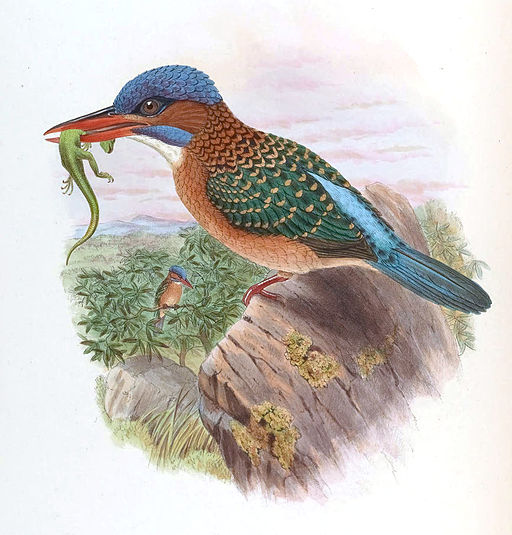Superregnum: Eukaryota
Regnum: Animalia
Subregnum: Eumetazoa
Cladus: Bilateria
Cladus: Nephrozoa
Superphylum: Deuterostomia
Phylum: Chordata
Cladus: Craniata
Subphylum: Vertebrata
Infraphylum: Gnathostomata
Superclassis: Tetrapoda
Cladus: Reptiliomorpha
Cladus: Amniota
Classis: Reptilia
Cladus: Eureptilia
Cladus: Romeriida
Subclassis: Diapsida
Cladus: Sauria
Infraclassis: Archosauromorpha
Cladus: Crurotarsi
Divisio: Archosauria
Subsectio: Ornithodira
Subtaxon: Dinosauromorpha
Cladus: Dinosauria
Ordo: Saurischia
Cladus: Eusaurischia
Cladus: Theropoda
Cladus: Neotheropoda
Infraclassis: Aves
Cladus: Euavialae
Cladus: Avebrevicauda
Cladus: Pygostylia
Cladus: Ornithothoraces
Cladus: Euornithes
Cladus: Ornithuromorpha
Cladus: Ornithurae
Cladus: Carinatae
Parvclassis: Neornithes
Cohors: Neognathae
Ordo: Coraciiformes
Familia: Alcedinidae
Subfamilia: Halcyoninae
Genus: Actenoides
Species: Actenoides hombroni
Subspecies: A. h. burtoni
Name
Actenoides hombroni Bonaparte, 1850
References
Conspectus generum avium 1 p. 157
Vernacular names
čeština: Ledňáček modrotemenný
English: Blue-capped Kingfisher
Nederlands: Mindanao-bosijsvogel
Türkçe: Mavi şapkalı yalıçakpını
Hombron's kingfisher or the blue-capped kingfisher (Actenoides hombroni) is a species of bird in the family Alcedinidae endemic to the Philippines and found only on Mindanao. It is one of the most colorful kingfishers in the country having a dark blue (green for females) cap and wings with rufous spots, a striped rufous belly, white chin and red bill . Its natural habitats are on the upper ranges of tropical moist lowland forest and tropical moist montane forests. It is threatened by habitat loss.
Description
A male Blue-capped kingfisher in the wild.
EBird describes the bird as "A spectacular medium-sized kingfisher of foothill and montane forest on Mindanao with a thick red bill, a white throat, a blue rump, and faintly scaled rufous on the underparts and cheek, extending around the back of the neck. The male has a blue crown, blue tail, and blue wings with buff spots. The blue is replaced by green in the female. The male also has an additional blue moustache stripe. Unmistakable. More often seen than heard. Song, given at dawn, consists of a single downslurred whistle with a slightly metallic quality, “wee-ooo,” repeated every few seconds."[2]
These kingfishers exhibit sexual dimorphism in which the males have the eponymous dark blue-cap and dark blue wings. The females on the other hand have aqua-green cap and wings.[3]
Habitat and Conservation Status
Its natural habitats are on the upper ranges of tropical moist lowland forest and tropical moist montane forests having a wide altitude range of 100 -2,400 meters above sea level but with majority of records are above 1,000 masl. They are often found close to streams. [3]
IUCN has assessed this bird as vulnerable with its population estimated at 2,500 to 9,999 mature individuals and thought to still be decreasing. This species' main threat is habitat loss with wholesale clearance of forest habitats as a result of logging, agricultural conversion and mining activities occurring within the range. This species appears to show a preference for montane habitats which are most at risk from mining activities especially for chromite and nickel.
It occurs in a few protected areas like Pasonanca Natural Park, Mount Kitanglad National Park, Mount Apo National Park and Mt. Hilong-hilong Watershed but as with most areas in the Philippines protection and enforcement are lax.[4]
References
BirdLife International (2016). "Actenoides hombroni". IUCN Red List of Threatened Species. 2016: e.T22683542A92989371. doi:10.2305/IUCN.UK.2016-3.RLTS.T22683542A92989371.en. Retrieved 12 November 2021.
"Blue-capped Kingfisher". Ebird.
Allen, Desmond (2020). Birds of the Philippines. Barcelona: Lynx and Birdlife Guides International. pp. 212–213.
International), BirdLife International (BirdLife (2016-10-01). "IUCN Red List of Threatened Species: Actenoides hombroni". IUCN Red List of Threatened Species.
Retrieved from "http://en.wikipedia.org/"
All text is available under the terms of the GNU Free Documentation License


